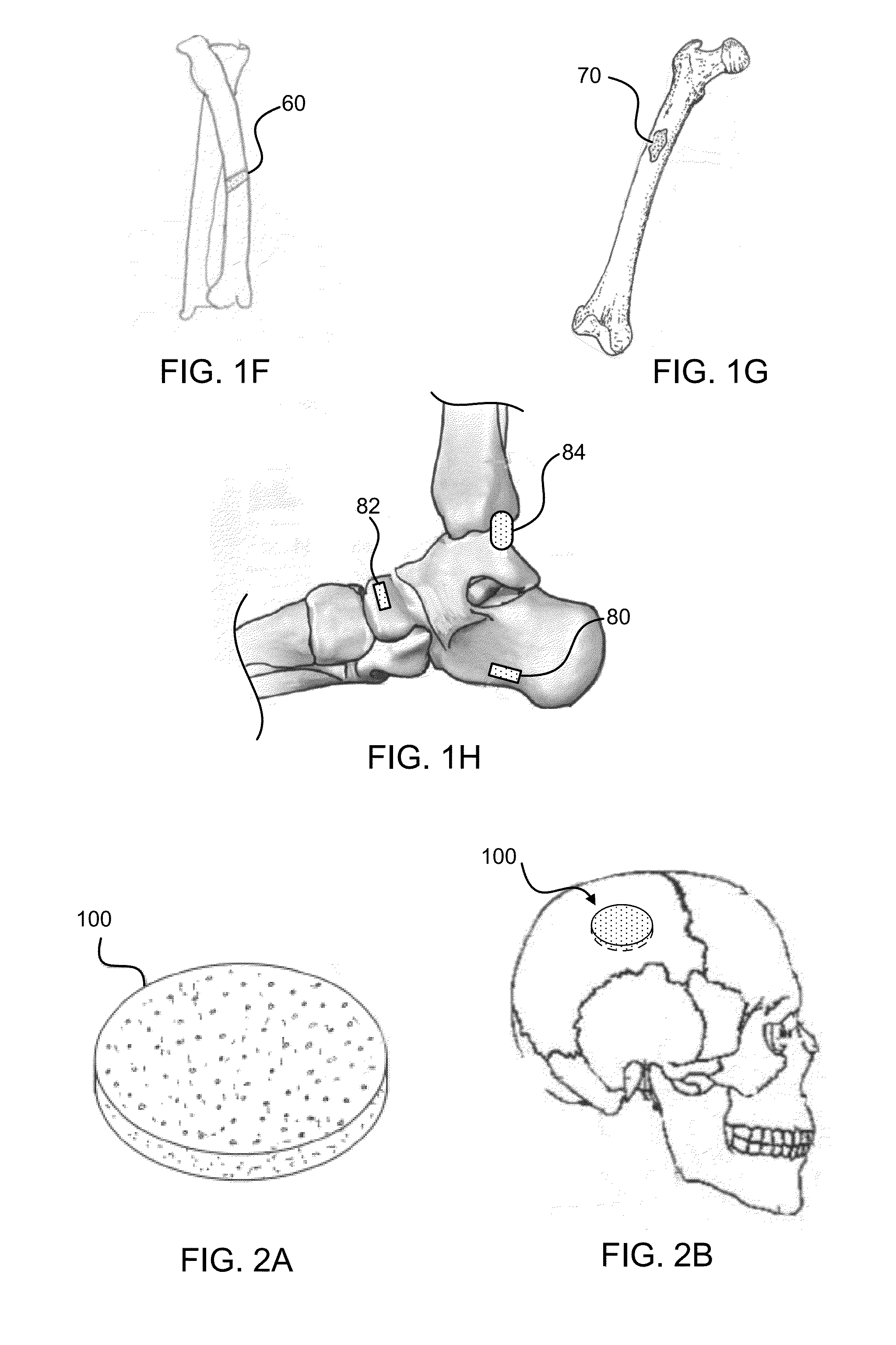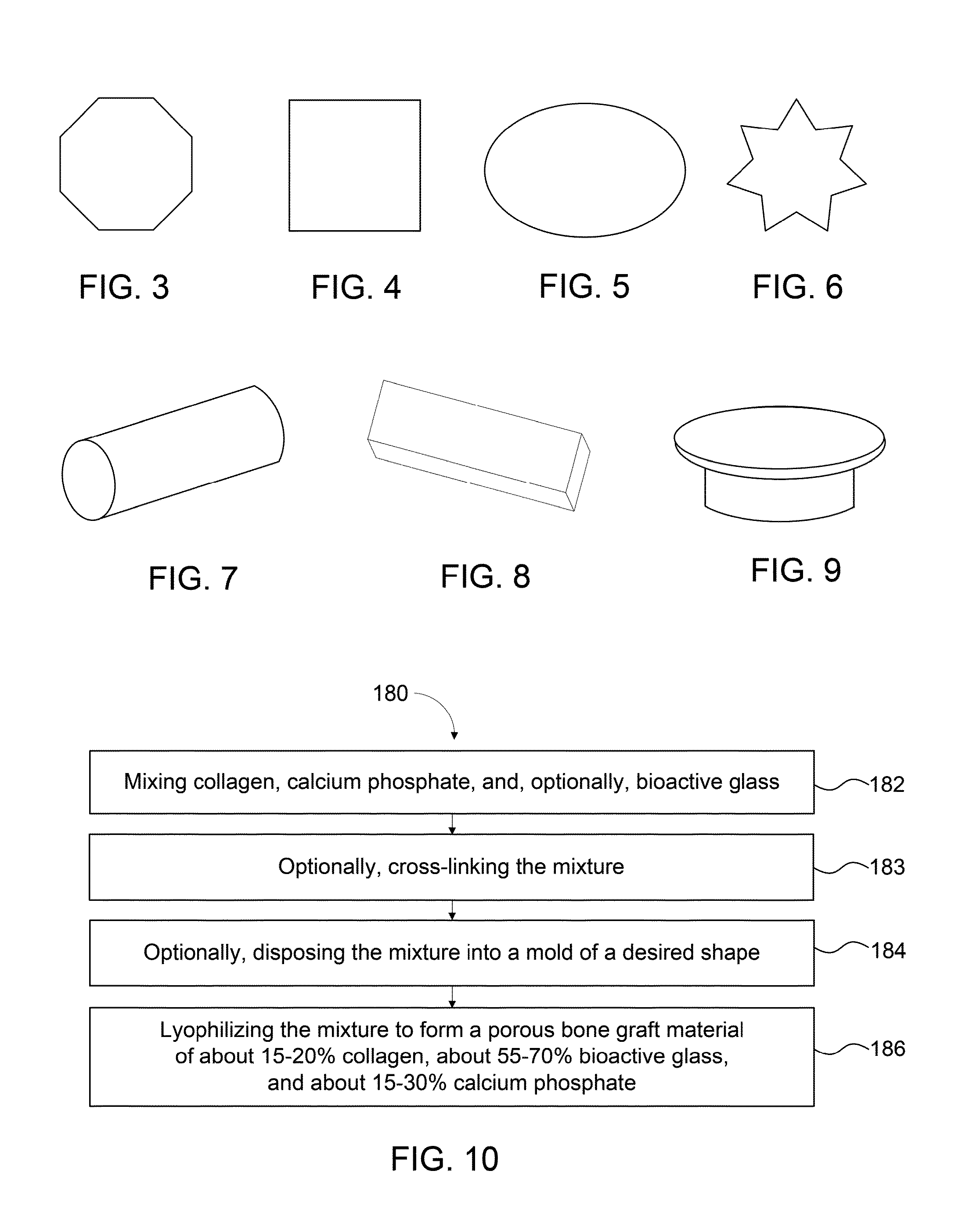Bone graft materials and methods
a technology of bone grafting and materials, applied in the field of bone grafting, can solve the problems of increasing pain and discomfort of patients, increasing the risk of infection, and increasing the risk of disease transmission and graft rejection of patients
- Summary
- Abstract
- Description
- Claims
- Application Information
AI Technical Summary
Benefits of technology
Problems solved by technology
Method used
Image
Examples
example 1
Cell Preparation
[0095]Osteoblast-like MG-63 cells were prepared per American Type Culture Collection (“ATCC”) instructions. From passage three, the MG63 cells were stored frozen at −70° C. in Eagle's minimum essential medium (“EMEM”) with 20% fetal bovine serum (“FBS”). In preparation for use, the MG63 cells were thawed and then grown for at least three passages using EMEM. After three passages, the cells were transferred to Dulbecco's modified EMEM (“DMEM”). The DMEM contained no glucose and was supplemented with ascorbic acid (50 μg / mL), 10 mM β-glycerophosphate, 50 UI / mL Penicillin-Streptomycin and 10% FBS. The cells were grown for at least three more passages at these conditions. The cells were maintained at 37±1° C. in a humidified incubator with 5±1% CO2. The media was changed every 2 to 3 days. After the cells became confluent on the last passage, they were harvested and counted.
example 2
[0096]Test samples of bone graft compositions including collagen, bioactive glass, and calcium phosphate (60% HA / 40% TCP) and test samples of bone graft compositions including collagen and bioactive glass were prepared. The following preparation and testing was performed for each bone graft composition test sample. Each compound (i.e., collagen, bioactive glass, and calcium phosphate, as applicable; ratios of compounds each test sample are described below in Examples 3 through 8) was weighed aseptically using an analytical scale under a biological safety cabinet and transferred to a sterile non-treated tissue culture Petri dish (60×15 mm). A 30 mg mixture of the compounds in the specified ratio was aseptically prepared. The 30 mg mixture was transferred to and divided amongst four Petri dishes, each non-treated. A 1 mL PBS was added to each dish. Each dish was then vigorously swirled by hand on a desk surface. Each dish was also spun in a centrifuge at 3000 rpm for...
example 3
Collagen:Bioactive Glass:Calcium Phosphate (15:65:20)
[0102]A test sample of a bone graft composition including 15% collagen, 65% bioactive glass, and 20% calcium phosphate (60% HA / 40% TCP) was prepared according to Example 2. Cell confluence was determined based on visual observation of the sample without staining, as shown in the images of the sample taken on day 2, day 5, and day 11 in FIGS. 11A-11C, respectively. Cell confluence reached nearly an average of 93% by day 5. Cell confluence reached about 100% by day 11. No cytotoxicity was observed when compared with cell controls. A chart of cell confluence of this Example 3 compared to Examples 4 and 5 below is shown in FIG. 13.
[0103]Referring to FIG. 12A, visual observation under light microscopy of the Van Kossa stained cells showed pink, large, prolonged cells with dark-red big nuclei. The cells were in a fairly thick multilayer with many aggregations. Some crystals and phosphates appeared intact, but with grayish aureole. Some ...
PUM
| Property | Measurement | Unit |
|---|---|---|
| size | aaaaa | aaaaa |
| size | aaaaa | aaaaa |
| porosity | aaaaa | aaaaa |
Abstract
Description
Claims
Application Information
 Login to View More
Login to View More - R&D
- Intellectual Property
- Life Sciences
- Materials
- Tech Scout
- Unparalleled Data Quality
- Higher Quality Content
- 60% Fewer Hallucinations
Browse by: Latest US Patents, China's latest patents, Technical Efficacy Thesaurus, Application Domain, Technology Topic, Popular Technical Reports.
© 2025 PatSnap. All rights reserved.Legal|Privacy policy|Modern Slavery Act Transparency Statement|Sitemap|About US| Contact US: help@patsnap.com



